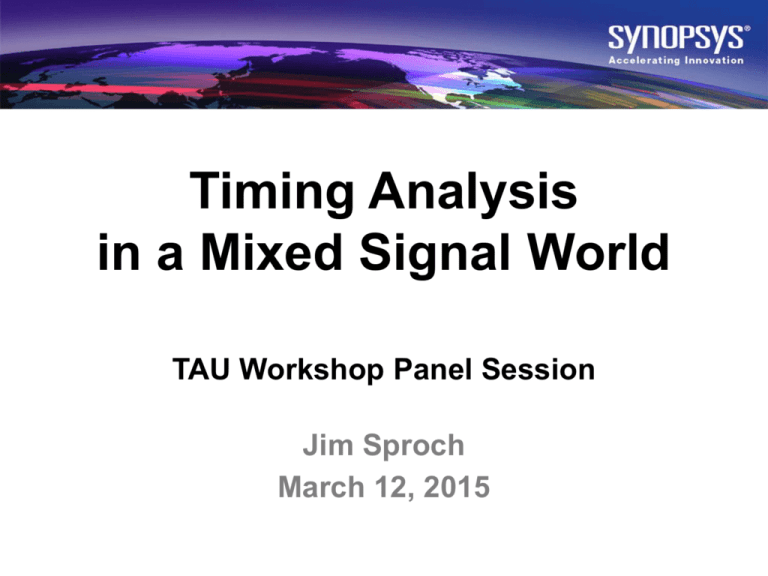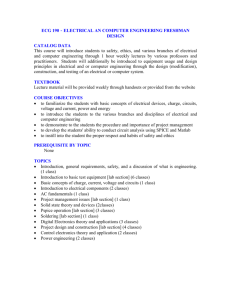
Timing Analysis
in a Mixed Signal World
TAU Workshop Panel Session
Jim Sproch
March 12, 2015
© 2015 Synopsys, Inc. All rights reserved. 1
Are Existing Delay Models Useful for
Mixed Signal Timing Analysis?
PrechgB
• Mixed signal designs comprise
a mix of digital, analog, and
analog-ish circuits
• Partitioning ideally puts model
boundaries at a digital interface
WL-N
WL-0
Wmux
WmuxB
RmuxB
Rmux
• Existing delay modeling syntax and semantics
were designed for digital circuit applications
SA-PrechgB
SAenable
– Some properties are transferrable to mixed signal
– Capacitance, pulse noise, voltage swing, current source/sink
– Some analog mixed signal properties are absent
– Gain, bandpass, analog noise, frequency response,
jitter, phase error, acquisition and tracking range
© 2015 Synopsys, Inc. All rights reserved. 2
DataOut
Abstract Models for Mixed Signal
• Encapsulation of function and key interface parameters
– Functionality, timing, noise, variation (LVF), drive strength
– Electromigration (EM), pin load capacitance, static/dynamic power
• Liberty™ open-source standard for library models
– Non-linear table format (NLDM)
– Current-source format (CCS, ECSM)
– Diverse industry participation via LTAB
• Complementary interoperability with IEEE-1801
(UPF, CPF) power intent standard
© 2015 Synopsys, Inc. All rights reserved. 3
Do Models Work for Mixed Signal?
• Model interfaces are a challenge for even digital circuits
– Non-linear waveform effects
– Simultaneous, or near-simultaneous switching
– Complex input impedance
• Models do add value for mixed signal designs
– Encapsulation in a black box model for hierarchical verification
– Pin-to-pin arcs to support timing propagation
• Technical challenges
– External cross-talk
– Impedance shielding
– Composite and macro modeling
© 2015 Synopsys, Inc. All rights reserved. 4
Transistor-Level Static Timing Analysis
• STA for custom digital and interface circuits
–
–
–
–
Hierarchical SPICE netlist and transistor model card input
Exhaustive, vector-free verification of digital timing constraints
Support for digital circuits in an analog context, e.g. DCVSL, SerDes
Support for memories and particular analog-ish circuit topologies
VddH
• Timing constraint coverage
– Complete set of combinational and sequential checks
– Setup, hold, recovery, removal, min pulse width
LVsig
VddL
– Mixed-signal checks include
– Differential clock and data signals, sense amp enable,
synchronizers, precharge, level shifters, contention resolution
– Ultra-fast custom digital circuits: Verilog-A monitor in every DFF instance
– Characterization to encapsulate in a Liberty extracted timing model
• Technical challenges
– Full analog circuits, PLL, ADC, DAC, switch-cap, LRC
© 2015 Synopsys, Inc. All rights reserved. 5
HVsig
Co-Simulation for Mixed Signal Designs
• Combine SPICE with a logic simulator
• Functional, timing, and power-up simulation
– High throughput
– Excellent accuracy
• Let SPICE do what SPICE does best, and use fast
logic simulation to handle RTL and gate-level circuits
– Various SPICE engines, +
– SystemVerilog, Verilog, Verilog-A, Verilog-AMS, or VHDL
• Direct kernel integration of SPICE and logic simulation
– Single process, single executable
– Multi-level verification
• Use abstracted models for system-level validation
© 2015 Synopsys, Inc. All rights reserved. 6
Bottom Line
• Mixed signal modeling and timing analysis CAN be done
– Enables ultra-fast, ultra-small, ultra-low-power designs
– Valuable verification technique to ensure working first silicon
• Technical challenges
– MS circuit timing analysis is not necessarily easy or exhaustive
– Labor and compute resources can be expensive
– Costs may really explode with increasing number of corners
• Continuing progress
– Modeling interface improvements
– Expanding analysis support for analog-ish circuits
© 2015 Synopsys, Inc. All rights reserved. 7
Thank You
© 2015 Synopsys, Inc. All rights reserved. 8












